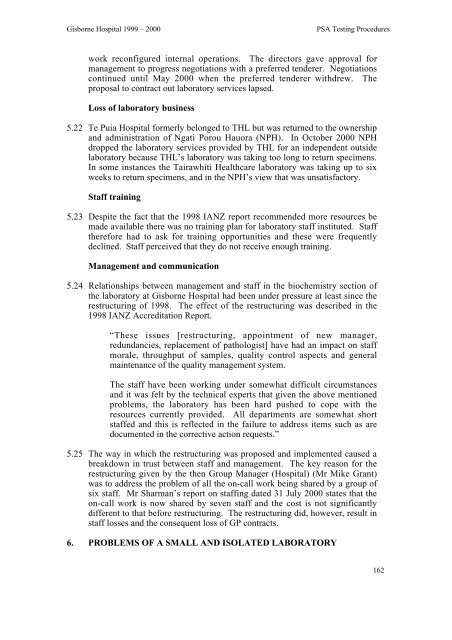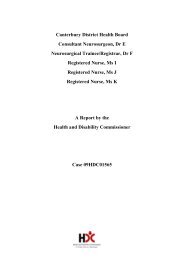Gisborne Hospital Report - Health and Disability Commissioner
Gisborne Hospital Report - Health and Disability Commissioner
Gisborne Hospital Report - Health and Disability Commissioner
Create successful ePaper yourself
Turn your PDF publications into a flip-book with our unique Google optimized e-Paper software.
<strong>Gisborne</strong> <strong>Hospital</strong> 1999 – 2000<br />
PSA Testing Procedures<br />
work reconfigured internal operations. The directors gave approval for<br />
management to progress negotiations with a preferred tenderer. Negotiations<br />
continued until May 2000 when the preferred tenderer withdrew. The<br />
proposal to contract out laboratory services lapsed.<br />
Loss of laboratory business<br />
5.22 Te Puia <strong>Hospital</strong> formerly belonged to THL but was returned to the ownership<br />
<strong>and</strong> administration of Ngati Porou Hauora (NPH). In October 2000 NPH<br />
dropped the laboratory services provided by THL for an independent outside<br />
laboratory because THL’s laboratory was taking too long to return specimens.<br />
In some instances the Tairawhiti <strong>Health</strong>care laboratory was taking up to six<br />
weeks to return specimens, <strong>and</strong> in the NPH’s view that was unsatisfactory.<br />
Staff training<br />
5.23 Despite the fact that the 1998 IANZ report recommended more resources be<br />
made available there was no training plan for laboratory staff instituted. Staff<br />
therefore had to ask for training opportunities <strong>and</strong> these were frequently<br />
declined. Staff perceived that they do not receive enough training.<br />
Management <strong>and</strong> communication<br />
5.24 Relationships between management <strong>and</strong> staff in the biochemistry section of<br />
the laboratory at <strong>Gisborne</strong> <strong>Hospital</strong> had been under pressure at least since the<br />
restructuring of 1998. The effect of the restructuring was described in the<br />
1998 IANZ Accreditation <strong>Report</strong>.<br />
“These issues [restructuring, appointment of new manager,<br />
redundancies, replacement of pathologist] have had an impact on staff<br />
morale, throughput of samples, quality control aspects <strong>and</strong> general<br />
maintenance of the quality management system.<br />
The staff have been working under somewhat difficult circumstances<br />
<strong>and</strong> it was felt by the technical experts that given the above mentioned<br />
problems, the laboratory has been hard pushed to cope with the<br />
resources currently provided. All departments are somewhat short<br />
staffed <strong>and</strong> this is reflected in the failure to address items such as are<br />
documented in the corrective action requests.”<br />
5.25 The way in which the restructuring was proposed <strong>and</strong> implemented caused a<br />
breakdown in trust between staff <strong>and</strong> management. The key reason for the<br />
restructuring given by the then Group Manager (<strong>Hospital</strong>) (Mr Mike Grant)<br />
was to address the problem of all the on-call work being shared by a group of<br />
six staff. Mr Sharman’s report on staffing dated 31 July 2000 states that the<br />
on-call work is now shared by seven staff <strong>and</strong> the cost is not significantly<br />
different to that before restructuring. The restructuring did, however, result in<br />
staff losses <strong>and</strong> the consequent loss of GP contracts.<br />
6. PROBLEMS OF A SMALL AND ISOLATED LABORATORY<br />
162
















